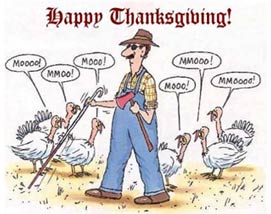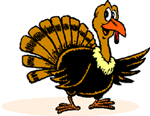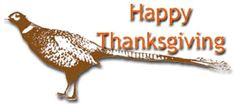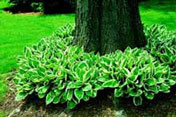| |

DUCK,
DUCK, GOOSE!
- Ed Jensen
In
the 1960's, Canadian Geese were fast approaching extinction with
populations numbering around 1000. Today, they are well in excess
of 1 million. Properties everywhere are now full of them and the
gifts they leave behind. What can you do? Here is a list of options
to consider:
1.
A pond can have high-test fishing line strung like a grid in 10'x
10' sections. People think the geese will see it and not have a
smooth take-off or landing area. We don't know what the geese think.
2.
No-mow area around the lake perimeter. Geese think there is a predator
in the tall vegetation, which there might well be. That could include
raccoons, turtles, snakes…. Nah, I'll mow around the lake,
thanks.
3.
Trumpeter swans are a natural predator, unless of course you get
a wimpy one, and they will leave the same gifts as the geese. Kind
of defeats the purpose, doesn't it?
4.
Scarecrows. Not the kind you see in farms, but a stake in the ground
with heavyweight plastic or Mylar affixed to it like a flag. The
fluttering and noisy flapping is thought to annoy the geese, and
the "scarecrows" do so much for the aesthetics of the
property.
 5.
Noisemakers. People have tried fireworks, car horns, sirens, air
horns and whistles, but they can't figure out how to get the geese
to light the fireworks, or blow the horns and whistles. 5.
Noisemakers. People have tried fireworks, car horns, sirens, air
horns and whistles, but they can't figure out how to get the geese
to light the fireworks, or blow the horns and whistles.
6.
Fences. Barriers that discourage flight; electric fences and low
(1-3') barricades. Again, a welcome addition to the curb appeal
of your property.
7.
Ultrasound. Don't even ask.
8.
Dogs. Border Collies can be leased or purchased to run at the geese
and chase them off. Then you only have to worry about what the dogs
leave behind.
9.
Change your landscape program. Geese prefer lakes or ponds surrounded
by lawn, especially lawns that are maintained. Quit fertilizing
your lawn and cutting your grass and in no time those geese will
look for a more appealing place to be. Of course, so will all your
tenants.
10.
Flight Control. This is a product made from grape seed extract sprayed
on lawns and sidewalks. The geese see a different color that they
don't like and do not land. We do not know who asked the geese which
colors they prefer to land on.
 Then
there's the OLM tried and true method, our own Melody from the admin
staff, with a little coaching from Tommy! Then
there's the OLM tried and true method, our own Melody from the admin
staff, with a little coaching from Tommy!
There
is no one cure, unfortunately. Check with your landscaper and/or
ask OLM which method may have the best results for your particular
property. Just don't forget to watch your step!

|
Nature
is, above all, profligate. Don't believe them when they tell
you how
economical and thrifty nature is, whose leaves return to the
soil.
Wouldn't
it be cheaper to leave them on the tree in the first place?
-
Annie Dillard
|



|
Autumn
is a season followed immediately by looking forward to Spring.
-
Anonymous
|


|
|
|
For
man, autumn is a time of harvest, of gathering together.
For
nature, it is a time of sowing, of scattering abroad.
-
Edwin Way Teale
|

|
HIBERNATING
NOT JUST FOR BEARS!
-
Ron Alexander
In
the same way that one "winterizes" a house or an
automobile, now that the growing season is coming to a close
it is time to think about what needs to be done to the lawn
and landscape in preparation for the coming winter months.
There are several functions that should be performed in the
landscape.
Turf
Fescue is a cool season turf, which means it should be looking
its best this time of year. Hopefully the overseed process
was successful and now there is a healthy stand of turf, which
will require feeding with a balanced fertilizer. The goal
is to promote the establishment of Fescue turf now to better
withstand the stresses of future summer weather. A weed pre-emergent
is also very important to help in preventing the winter weeds
that can contaminate the turf while it is not growing and
is unable to defend itself.
Perennials

Hostas |
Hostas
and Daylilies may be divided if you wish. Cut the foliage
to ground level, dig up the rootball and use a shovel to carefully
divide the root fibers into equal sections. Replant the sections
as desired, add a little fertilizer, then cover with 2-3 inches
of mulch. This is a cost effective way to expand perennial
areas while promoting vigorous growth and increased blooms.
 Winter
Pruning Winter
Pruning
While it is still a little early to begin winter pruning shrubs,
evaluate which shrubs have outgrown their space and therefore
must be reduced in size. Determine if any trees have issues
with building clearance, light obstruction, etc. Identify
groundcover materials that can be cut back for rejuvenation.
A game plan can be devised to ensure the entire objective
will be met. Do not begin rejuvenation pruning before the
first frost. Begin with perennials and groundcovers where
the foliage has begun to decline, then deciduous shrubs. Save
evergreen shrubs, especially Hollies, for last.
It
is a common misconception that not much happens in the landscape
during the winter months. The reality is that it is important
to use this time to prepare for the grueling summer ahead.
LETS GET STARTED!
|

 Need
help? Have questions? Whether it concerns home or
at work, contact OLM by phone, e-mail or fax and we will be
glad to assist! Need
help? Have questions? Whether it concerns home or
at work, contact OLM by phone, e-mail or fax and we will be
glad to assist! |


|
|


 5.
Noisemakers. People have tried fireworks, car horns, sirens, air
horns and whistles, but they can't figure out how to get the geese
to light the fireworks, or blow the horns and whistles.
5.
Noisemakers. People have tried fireworks, car horns, sirens, air
horns and whistles, but they can't figure out how to get the geese
to light the fireworks, or blow the horns and whistles. Then
there's the OLM tried and true method, our own Melody from the admin
staff, with a little coaching from Tommy!
Then
there's the OLM tried and true method, our own Melody from the admin
staff, with a little coaching from Tommy!


 Winter
Pruning
Winter
Pruning Need
help? Have questions? Whether it concerns home or
at work, contact OLM by phone, e-mail or fax and we will be
glad to assist!
Need
help? Have questions? Whether it concerns home or
at work, contact OLM by phone, e-mail or fax and we will be
glad to assist!